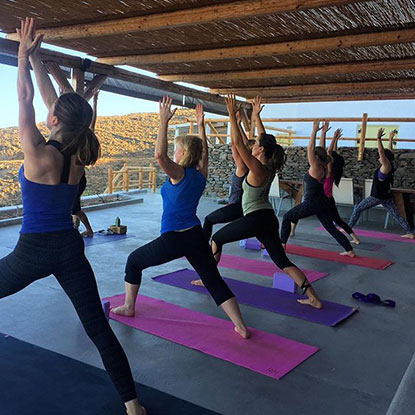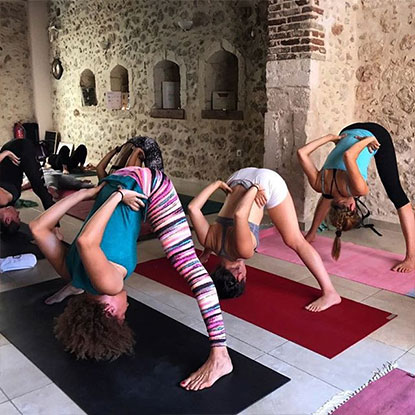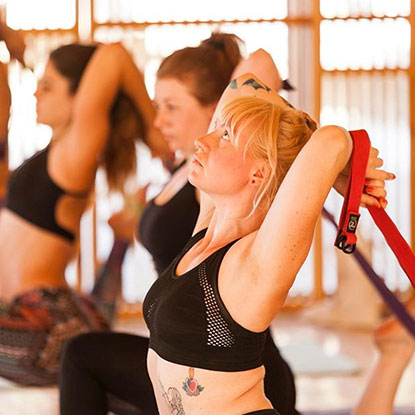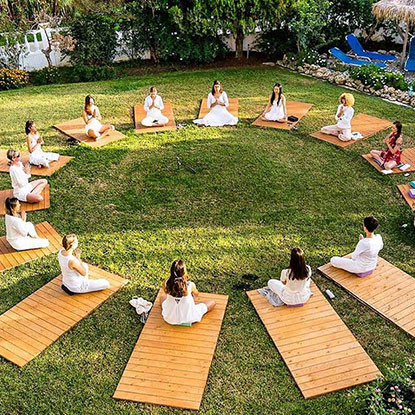
Studies continue to reveal the myriad of health benefits of Yoga, and Yoga is currently one of the most popular physical practices across the globe.
There are so many different types offered, that it can be difficult to choose the right one for you. This guide is about Types of Yoga: 9 Styles of Yoga along with their essential characteristics.
No matter which style of yoga you choose, you will likely see many improvements in different areas of your health. When practicing regularly, you can:
- Increase your flexibility
- Increase your energy
- Improve your posture
- Decrease chronic pain
- Increase muscle tone and strength
- Detoxify your organs
- Reduce injuries
- Improve your cardiovascular health & circulation
- Sleep better
- Improve your mental health (reduce anxiety & depression)
- Improve athletic performance
- Release endorphins and improve your mood
- And so much more…
1. Vinyasa Yoga / Flow Yoga / Power Yoga
Vinyasa is a very generalized type of yoga that encompasses many different styles. Essentially, vinyasa links the breath to moving between postures, with the focus on inhaling and expanding, exhaling, and contracting. It is a vigorous style based on a rapid flow through sun salutations. The flow is comparable and means flowing from one pose to another, sometimes wandering away from the salutation series. Want to learn everything about how to get a Vinyasa Yoga certification?
Vinyasa Yoga, along with Rocket Yoga, Jivamukti, and Power Yoga, come from Ashtanga Yoga. Would you like to know more about the difference between Ashtanga and Vinyasa Yoga?

Do you want to deepen your yoga practice?

2. Ashtanga Yoga
Ashtanga is a system of yoga that was brought to the modern world by yogi Sri K. Pattabhi Jois. There are several series included within an Ashtanga practice, starting with the primary series and increasing in difficulty as you progress through the levels. It is a fast-paced, physically challenging practice with a set sequence of asanas, offered in most studios both guided and Mysore (where a student is able to move at their own pace, assessed by senior instructors.
Want to read about 6 ways to start and maintain an Ashtanga practice?
3. Hatha Yoga
Hatha Yoga is a broad category that encompasses most of the types of yoga that are based on physical practice. This style of yoga offered in a studio can vary greatly and is often more focused on teaching the beginner. Most classes will have a slower pace, holding poses for longer amounts of time, with instructions to introduce pranayama (breathing techniques), meditation, and correct alignment in asana (postures).


4. Iyengar Yoga
Developed by BKS Iyengar, this type of yoga is a very meticulous style with attention placed on finding the correct alignment in a pose. Iyengar's style guides the student into experiencing the intense subtleties of each pose by using a wide array of props, including bolsters, chairs, straps, blocks, etc. Poses are held much longer than in almost any other type of yoga.
Want to learn how to do a headstand?
5. Anusara Yoga
Discovered by Doug Friend, Anusara is a more modern approach to Hatha, using physical postures to support the students in opening their hearts, experiencing grace, and finding inner peace. Anusara can be an intense practice, incorporating Vinyasa, yet focuses on “The Universal Principles of Alignment” where one focuses on the natural spirals and loops of the body. This practice also brings attention to three main categories of practice known as the three A’s - Attitude, alignment, and action. Continue reading our guide on Types of Yoga: 9 Styles of Yoga.
6. Kundalini Yoga
Brought to the West by Yogi Bhajan, this form of yoga feels and looks quite different than any other type. The focus is to awaken one’s Kundalini energy from the base of the spine up through the 7 chakras. Each sequence is referred to as a kris through repetitive, enhanced breathing, movement, chants, mantras and meditation.

7. Bikram Yoga / Hot Yoga
Founded by Bikram Choudhury, consistency can be expected in this heated room, where a student is led through the same, copyrighted, 26 postures and 2 breathing techniques. The series is challenging, both mentally and physically, and is claimed to be all one needs to heal and strengthen one’s body. Hot Yoga often varies in temperature, humidity, and type and encompasses practicing yoga in a hot room. Continue reading our guide on Types of Yoga: 9 Styles of Yoga.

8. Yin Yoga
Yin is a slow-paced, challenging practice where static poses are held for two to five minutes and often longer. The focus of this practice is to improve circulation and flexibility by working on fascia, tendons, and ligaments.
9. Restorative Yoga
Restorative is another slower-paced yoga focused on healing the body through relaxation, calm, and discharging the nervous system. Poses are also held for longer amounts of time, yet props are incorporated into all of the poses to relieve the muscles and bones of their roles of support and action. When fully immersed in the poses and completely supported by props, the nervous system has the ability to slow down. This offers the body an opportunity to repair, rejuvenate and recharge. We recommend you continue reading our guide on Types of Yoga: 9 Styles of Yoga.
10. Trendy Yoga - Styles of Yoga
There are many different types of yoga consistently emerging to keep busy Westerners engaged, including Vino & Vinyasa (Yoga with Wine), Ganjanasana (Cannabis & Yoga), Brewga (Yoga & Beer), Goat Yoga, Heavy Metal Yoga, Dog and/or Cat Yoga, Naked Yoga, Anti-gravity Yoga (using silks, aerial apparatuses, or bungee systems), and so many more.
All of this being said, here is a small breakdown of just a few types of yoga currently being offered. Try out different Types of Yoga: 9 Styles of Yoga until you find the ones that fit your lifestyle, fitness level, and goals.
Are you interested in becoming a yoga teacher, or would you like to refine your teaching skills? Either way, we've got you covered in one course.
Find out more about our 200-hour yoga teacher training in Europe and our 300-hour advanced yoga teacher training in Europe.
9 Tips to Know Before Choosing Your YTT.





